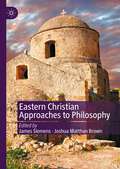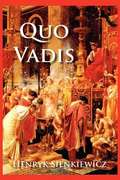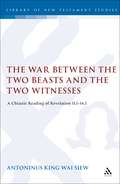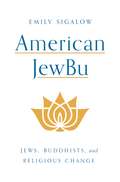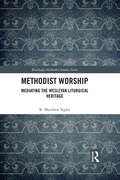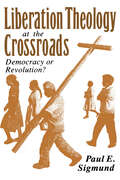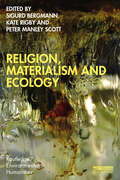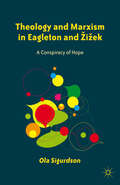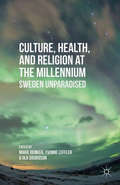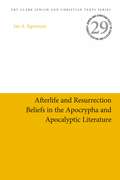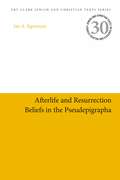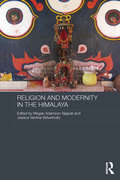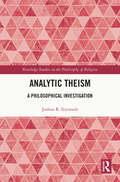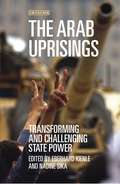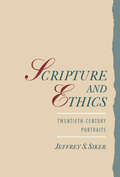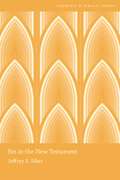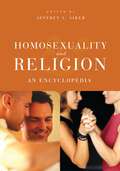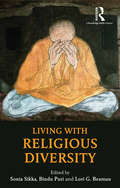- Table View
- List View
Eastern Christian Approaches to Philosophy
by James Siemens Joshua Matthan BrownWith few exceptions, the field of Eastern Christian studies has primarily been concerned with historical-critical analysis, hermeneutics, and sociology. For the most part it has not attempted to bring Eastern Christian philosophy into serious engagement with contemporary thought. This volume seeks to redress the matter by bringing the Eastern Christian tradition into a meaningful dialogue with contemporary philosophy. It boasts a diverse group of scholars—specialists in ancient philosophy, analytic philosophy, and continental philosophy—who engage with a wide range of pressing issues. Among other things, it addresses such topics as contemporary atheism, the metaphysics of action, religious epistemology, the philosophy of language, bioethics, the philosophy of race, and human rights. In so doing, it aims to introduce contemporary readers to unique perspectives and novel arguments often overlooked by mainstream anglophone philosophy.
Quo Vadis: A Narrative of the Time of Nero
by Henryk SienkiewiczHenryk Sienkiewicz (1846-1916) won the 1905 Nobel Prize in Literature. A brilliant Polish writer and patriot, he is possibly best known abroad for his monumental historical epic Quo Vadis that portrays the vibrant and dissonant combination of cruel excesses and decadence of Rome during the reign of the corrupt Emperor Nero and the high faith of the emerging era of early Christianity. Quo Vadis: A Narrative of the Time of Nero, is a love story of Marcus Vinicius, a passionate young Roman tribune, and Lygia Callina, a beautiful and gentle Christian maiden of royal Lygian descent and a hostage of Rome, raised in a patrician home. At first Marcus, a typical aristocratic Roman libertine of his time, has no notion of love and merely desires Lygia with erotic animalistic intensity. Through political machinations of the elegant Petronius he contrives to have her taken by force from her foster home and into the decadent and terrible splendor of the court of Ceasar, setting in motion a course of events that culminate in his own spiritual redemption. Intricately researched, populated with vibrant historical figures, and gorgeous period detail, bloody spectacle and intimate beauty, this is an epic tapestry of the triumph of love, faith and sacrifice.
The War Between the Two Beasts and the Two Witnesses: A Chiastic Reading of Revelation 11:1-14:5 (The Library of New Testament Studies #283)
by Tony SiewSiew seeks to examine the events that will unfold within the three and a half years before the dawn of the kingdom of God on earth. He argues that John composed the textual unit of Rev 11:1--14:5 as a coherent and unified literary unit structured in a macro-chiasm. He pays special attention to the fusion of form and content and seeks to elucidate how the concentric and chiastic pattern informs the meaning of the literary units within 11:1--14:5, and proposes that the text of 11:1--14:5 is best analyzed using Hebraic literary conventions, devices, and compositional techniques such as chiasm, parallelism, parataxis, and structural parallelism. The macro-chiastic pattern provides the literary-structural framework for John to portray that the events of the last three and a half years unfold on earth as a result of what transpires in heaven. Specifically, the war in heaven between Michael and the dragon has earthly ramifications. The outcome of the heavenly war where Satan is defeated and thrown out of heaven to earth results in the war on earth between the two beasts of Rev 13 and the two witnesses of Rev 11. The narrative of the war in heaven (12:7-12) is seen as the pivot of the macro-chiastic structure. Siew pays close attention to the time-period of the three-and-a-half years as a temporal and structural marker which functions to unite the various units in 11:1--14:5 into a coherent and integral whole. The events of the last days will be centred in Jerusalem.
American JewBu: Jews, Buddhists, and Religious Change
by Emily SigalowA revealing look at the Jewish American encounter with BuddhismToday, many Jewish Americans are embracing a dual religious identity, practicing Buddhism while also staying connected to their Jewish roots. This book tells the story of Judaism's encounter with Buddhism in the United States, showing how it has given rise to new contemplative forms within American Judaism—and shaped the way Americans understand and practice Buddhism.Taking readers from the nineteenth century to today, Emily Sigalow traces the history of these two traditions in America and explains how they came together. She argues that the distinctive social position of American Jews led them to their unique engagement with Buddhism, and describes how people incorporate aspects of both into their everyday lives. Drawing on a wealth of original in-depth interviews conducted across the nation, Sigalow explores how Jewish American Buddhists experience their dual religious identities. She reveals how Jewish Buddhists confound prevailing expectations of minority religions in America. Rather than simply adapting to the majority religion, Jews and Buddhists have borrowed and integrated elements from each other, and in doing so they have left an enduring mark on the American consciousness.American JewBu highlights the leading role that American Jews have played in the popularization of meditation and mindfulness in the United States, and the profound impact that these two venerable traditions have had on one another.
American JewBu: Jews, Buddhists, and Religious Change
by Emily SigalowA revealing look at the Jewish American encounter with BuddhismToday, many Jewish Americans are embracing a dual religious identity, practicing Buddhism while also staying connected to their Jewish roots. This book tells the story of Judaism's encounter with Buddhism in the United States, showing how it has given rise to new contemplative forms within American Judaism—and shaped the way Americans understand and practice Buddhism.Taking readers from the nineteenth century to today, Emily Sigalow traces the history of these two traditions in America and explains how they came together. She argues that the distinctive social position of American Jews led them to their unique engagement with Buddhism, and describes how people incorporate aspects of both into their everyday lives. Drawing on a wealth of original in-depth interviews conducted across the nation, Sigalow explores how Jewish American Buddhists experience their dual religious identities. She reveals how Jewish Buddhists confound prevailing expectations of minority religions in America. Rather than simply adapting to the majority religion, Jews and Buddhists have borrowed and integrated elements from each other, and in doing so they have left an enduring mark on the American consciousness.American JewBu highlights the leading role that American Jews have played in the popularization of meditation and mindfulness in the United States, and the profound impact that these two venerable traditions have had on one another.
Methodist Worship: Mediating the Wesleyan Liturgical Heritage (Routledge Methodist Studies Series)
by R. Matthew SiglerWhat makes Methodist worship "Methodist" or "Wesleyan?" How do Methodists evaluate emerging forms of worship in light of their own liturgical heritage? This book considers these questions by bringing to light the work and significance of three Methodist liturgists who have until now received precious little scholarly focus: Thomas O. Summers (1812-1882), Nolan B. Harmon (1892-1993), and James F. White (1932-2004). Exploring each one’s contribution to the Methodist movement, it evaluates their continuing legacies as scholars and practitioners of Methodist worship. Importantly, the work of all these men occurred during times of cultural change, which gave rise to new ways of worship within the landscape of American Methodism. Addressing them in chronological order, this study shows how each figure enacted liturgical reform and renewal by drawing from the liturgical textual tradition inherited directly from John Wesley’s Sunday Service of the Methodist in North America as well as the hymnody of Charles Wesley. It also demonstrates how they sought to inculturate the Wesleyan liturgical tradition in the midst of these significant changes. Evaluating historic and emerging trends in Methodist liturgical praxis, this is a book that will be of great interest to scholars of Methodism, the History of Religion, Liturgical Studies and Theology.
Methodist Worship: Mediating the Wesleyan Liturgical Heritage (Routledge Methodist Studies Series)
by R. Matthew SiglerWhat makes Methodist worship "Methodist" or "Wesleyan?" How do Methodists evaluate emerging forms of worship in light of their own liturgical heritage? This book considers these questions by bringing to light the work and significance of three Methodist liturgists who have until now received precious little scholarly focus: Thomas O. Summers (1812-1882), Nolan B. Harmon (1892-1993), and James F. White (1932-2004). Exploring each one’s contribution to the Methodist movement, it evaluates their continuing legacies as scholars and practitioners of Methodist worship. Importantly, the work of all these men occurred during times of cultural change, which gave rise to new ways of worship within the landscape of American Methodism. Addressing them in chronological order, this study shows how each figure enacted liturgical reform and renewal by drawing from the liturgical textual tradition inherited directly from John Wesley’s Sunday Service of the Methodist in North America as well as the hymnody of Charles Wesley. It also demonstrates how they sought to inculturate the Wesleyan liturgical tradition in the midst of these significant changes. Evaluating historic and emerging trends in Methodist liturgical praxis, this is a book that will be of great interest to scholars of Methodism, the History of Religion, Liturgical Studies and Theology.
Liberation Theology at the Crossroads: Democracy or Revolution?
by Paul E. SigmundLiberation theology originated in Catholic Latin America at the end of the 1960s in response to prevalent conditions of poverty and oppression. Its basic tenet was that it is the primary duty of the church to seek to promote social and economic justice. Since that time it has grown in influence, spreading to other areas of the Third World, along with bitter controversy about its ties to Marxist ideology and violent revolution. Drawing on both English and Spanish sources, this critical study examines the history, method, and doctrines of liberation theology. Sigmund considers the movement's origins in political circumstances in Latin America and provides case studies of its role in such events as the revolution and counter-revolution in Chile, and in the revolutionary movements in El Salvador and Nicaragua. Examining the thought of major liberation theologians, as well as the critical responses of the Vatican, Sigmund shows that liberation theology is a complex phenomenon, comprising a variety of kinds and degrees of radicalism. He discerns a general trend away from the Marxist rhetoric that has often characterized the movement in the past and towards the kind of grassroots populist reform typified by the Basic Christian Communities Movement.
Religion, Materialism and Ecology (Routledge Environmental Humanities)
by Sigurd Bergmann, Kate Rigby and Peter Manley ScottThis timely collection of essays by leading international scholars across religious studies and the environmental humanities advances a lively discussion on materialism in its many forms. While there is little agreement on what ‘materialism’ means, it is evident that there is a resurgence in thinking about matter in more animated and active ways. The volume explores how debates concerning the new materialisms impinge on religious traditions and the extent to which religions, with their material culture and beliefs in the Divine within the material, can make a creative contribution to debates about ecological materialisms. Spanning a broad range of themes, including politics, architecture, hermeneutics, literature and religion, the book brings together a series of discussions on materialism in the context of diverse methodologies and approaches. The volume investigates a range of issues including space and place, hierarchy and relationality, the relationship between nature and society, human and other agencies, and worldviews and cultural values. Drawing on literary and critical theory, and queer, philosophical, theological and social theoretical approaches, this ground-breaking book will make an important contribution to the environmental humanities. It will be a key read for postgraduate students, researchers and scholars in religious studies, cultural anthropology, literary studies, philosophy and environmental studies.
Theology and Marxism in Eagleton and Žižek: A Conspiracy of Hope
by O. SigurdsonTaking its cue from the renewed interest in theology among Marxist and politically radical philosophers or thinkers, this study inquires into the reasons for this interest in theology focusing on the British literary theorist Terry Eagleton and the Slovenian philosopher and psychoanalyst Slavoj Žižek, as two contemporary prominent Marxist thinkers.
Culture, Health, and Religion at the Millennium: Sweden Unparadised
by Ola Sigurdson Marie Demker Yvonne LefflerThe book presents interpretations of culture, health, politics, and religion in Sweden today, Sweden transforms from the well-functioning but existentially bland economic wonder to a more fragmented and gloomy society. Contributors include scholars from film studies, literary studies, political science, religious studies and theology
Afterlife and Resurrection Beliefs in the Apocrypha and Apocalyptic Literature (Jewish and Christian Texts)
by Jan Age SigvartsenJan A. Sigvartsen seeks to examine the immense interest in life after death, and speculation about the fates awaiting both the righteous and the wicked, that proliferated in the Second Temple period. In this volume Sigvartsen explores the Apocrypha and the apocalyptic writings in the Pseudepigrapha. He identifies the numerous afterlife and resurrection beliefs and presents an analysis that enables readers to easily understand and compare the wide-ranging beliefs regarding the afterlife that these texts hold.A careful reading of these resurrection passages, including passages appearing in Sirach, Maccabees, the Sibylline Oracles and the Ezra texts, reveals that most of the distinct views on life-after-death, regardless of their complexity, show little evidence of systematic development relational to one another, and are often supported by several key passages or shared motifs from texts that later became a part of the TaNaKh. Sigvartsen also highlights the factors that may have influenced the development of so many different resurrection beliefs; including anthropology, the nature of the soul, the scope of the resurrection, the number and function of judgments, and the final destination of the righteous and the wicked. Sigvartsen's study provides a deeper understanding of how the “TaNaKh” was read by different communities during this important period, and the role it played in the development of the resurrection belief – a central article of faith in both Christianity and Rabbinic Judaism.
Afterlife and Resurrection Beliefs in the Apocrypha and Apocalyptic Literature (Jewish and Christian Texts)
by Jan Age SigvartsenJan A. Sigvartsen seeks to examine the immense interest in life after death, and speculation about the fates awaiting both the righteous and the wicked, that proliferated in the Second Temple period. In this volume Sigvartsen explores the Apocrypha and the apocalyptic writings in the Pseudepigrapha. He identifies the numerous afterlife and resurrection beliefs and presents an analysis that enables readers to easily understand and compare the wide-ranging beliefs regarding the afterlife that these texts hold.A careful reading of these resurrection passages, including passages appearing in Sirach, Maccabees, the Sibylline Oracles and the Ezra texts, reveals that most of the distinct views on life-after-death, regardless of their complexity, show little evidence of systematic development relational to one another, and are often supported by several key passages or shared motifs from texts that later became a part of the TaNaKh. Sigvartsen also highlights the factors that may have influenced the development of so many different resurrection beliefs; including anthropology, the nature of the soul, the scope of the resurrection, the number and function of judgments, and the final destination of the righteous and the wicked. Sigvartsen's study provides a deeper understanding of how the “TaNaKh” was read by different communities during this important period, and the role it played in the development of the resurrection belief – a central article of faith in both Christianity and Rabbinic Judaism.
Afterlife and Resurrection Beliefs in the Pseudepigrapha (Jewish and Christian Texts)
by Jan Age SigvartsenJan A. Sigvartsen seeks to examine the immense interest in life after death, and speculation about the fates awaiting both the righteous and the wicked, that proliferated in the Second Temple period. In this volume Sigvartsen analyses the texts of the Pseudepigrapha, identifies the numerous afterlife and resurrection beliefs they contain, and presents an analysis of these beliefs and how they functioned in the Second Temple period.A careful reading of these diverse resurrection passages – from testaments to wisdom, philosophical literature, and prayers – reveals that most of these distinct life-after-death views, regardless of their complexity, show little evidence of systematic development relational to one another, and are often supported by several key passages or shared motifs from texts that later became a part of the TaNaKh. This volume examines testaments from Adam to the Twelve Patriarchs, expansions of stories and legends such as Joseph and Aseneth and the ladder of Jacob, and texts such as 4 Maccabees, before finally considering the posthumous body, the nature of the soul, and anthropological implications. Sigvartsen's study provides a deeper understanding of how texts that later became a part of the TaNaKh were read by different communities during this important period, and the role they played in the development of the resurrection belief – a central article of faith in both Christianity and Rabbinic Judaism.This volume is a companion to Sigvartsen's work on afterlife and resurrection in the Apocrypha and the apocalyptic literature of the Pseudepigrapha.
Religion and Modernity in the Himalaya (Routledge Contemporary South Asia Series)
by Megan Adamson Sijapati Jessica Vantine BirkenholtzReligion has long been a powerful cultural, social, and political force in the Himalaya. Increased economic and cultural flows, growth in tourism, and new forms of governance and media, however, have brought significant changes to the religious traditions of the region in the twentieth and twenty-first centuries. This book presents detailed case studies of lived religion in the Himalaya in this context of rapid change to offer intra-regional perspectives on the ways in which lived religions are being re-configured or re-imagined. Based on original fieldwork, this book documents understudied forms of religion in the region and presents unique perspectives on the phenomenon and experience of religion, discussing why, when, and where practices, discourses, and the category of religion itself, are engaged by varying communities in the region. It yields fruitful insights into both the religious traditions and lived human experiences of Himalayan peoples in the modern era. Presenting new research and perspectives on the Himalayan region, this book should be of interest to students and scholars of South Asian Studies, Religious Studies, and Modernity.
Religion and Modernity in the Himalaya (Routledge Contemporary South Asia Series)
by Megan Adamson Sijapati Jessica Vantine BirkenholtzReligion has long been a powerful cultural, social, and political force in the Himalaya. Increased economic and cultural flows, growth in tourism, and new forms of governance and media, however, have brought significant changes to the religious traditions of the region in the twentieth and twenty-first centuries. This book presents detailed case studies of lived religion in the Himalaya in this context of rapid change to offer intra-regional perspectives on the ways in which lived religions are being re-configured or re-imagined. Based on original fieldwork, this book documents understudied forms of religion in the region and presents unique perspectives on the phenomenon and experience of religion, discussing why, when, and where practices, discourses, and the category of religion itself, are engaged by varying communities in the region. It yields fruitful insights into both the religious traditions and lived human experiences of Himalayan peoples in the modern era. Presenting new research and perspectives on the Himalayan region, this book should be of interest to students and scholars of South Asian Studies, Religious Studies, and Modernity.
Analytic Theism: A Philosophical Investigation (Routledge Studies in the Philosophy of Religion)
by Joshua R. SijuwadeThis book explores and develops a new philosophical argument for the existence of God from metaphysics. It focuses on exploring the pressing questions of God’s existence, the truth of theistic belief, and its relevance in modern philosophy. In doing so, it bridges the discussions and debates in the field of contemporary metaphysics with that of analytic philosophy of religion. At its core, metaphysics is dedicated to unveiling the fundamental structure of reality, playing a critical role in any intellectual endeavour in the quest for truth. However, a noticeable gap has persisted between today’s metaphysical conversations and the debates in analytic philosophy of religion, especially regarding the topic of God’s existence. In this book, the author embarks on a rigorous exploration, presenting an innovative a posteriori argument for theism, rooted in the latest evidence and theories from contemporary metaphysics. The first part of the book details the explanatory framework of the analysis, which is focused on introducing a new abductive methodology within metaphysics that provides a way for assessing the veracity of theism and the leading fundamental theories in contemporary metaphysics. The second part of the book then focuses on demonstrating how the central concepts and theories within contemporary metaphysics—such as quantum foundations, four-dimensionalism, formal ontology, essentialism, grounding, powerful causation, mereology, free will, personhood, and the reality of suffering—are best explained by the existence of God, and thus justify theism, over that of the competing theories within contemporary metaphysics. Theism is thus the best working metaphysical theory and should take a central place in fundamental enquiries within the field of contemporary metaphysics and beyond. Analytic Theism: A Philosophical Investigation is a must-read for scholars and advanced students venturing into philosophy of religion and metaphysics. Beyond its appeal to those in analytic philosophy of religion and metaphysics, this work also resonates with those immersed in contemporary philosophy on a whole and related fields of inquiry, serving as a pivotal read for anyone keen on the intersections of philosophy, theology, and science.
Analytic Theism: A Philosophical Investigation (Routledge Studies in the Philosophy of Religion)
by Joshua R. SijuwadeThis book explores and develops a new philosophical argument for the existence of God from metaphysics. It focuses on exploring the pressing questions of God’s existence, the truth of theistic belief, and its relevance in modern philosophy. In doing so, it bridges the discussions and debates in the field of contemporary metaphysics with that of analytic philosophy of religion. At its core, metaphysics is dedicated to unveiling the fundamental structure of reality, playing a critical role in any intellectual endeavour in the quest for truth. However, a noticeable gap has persisted between today’s metaphysical conversations and the debates in analytic philosophy of religion, especially regarding the topic of God’s existence. In this book, the author embarks on a rigorous exploration, presenting an innovative a posteriori argument for theism, rooted in the latest evidence and theories from contemporary metaphysics. The first part of the book details the explanatory framework of the analysis, which is focused on introducing a new abductive methodology within metaphysics that provides a way for assessing the veracity of theism and the leading fundamental theories in contemporary metaphysics. The second part of the book then focuses on demonstrating how the central concepts and theories within contemporary metaphysics—such as quantum foundations, four-dimensionalism, formal ontology, essentialism, grounding, powerful causation, mereology, free will, personhood, and the reality of suffering—are best explained by the existence of God, and thus justify theism, over that of the competing theories within contemporary metaphysics. Theism is thus the best working metaphysical theory and should take a central place in fundamental enquiries within the field of contemporary metaphysics and beyond. Analytic Theism: A Philosophical Investigation is a must-read for scholars and advanced students venturing into philosophy of religion and metaphysics. Beyond its appeal to those in analytic philosophy of religion and metaphysics, this work also resonates with those immersed in contemporary philosophy on a whole and related fields of inquiry, serving as a pivotal read for anyone keen on the intersections of philosophy, theology, and science.
The Arab Uprisings: Transforming and Challenging State Power (Library of Modern Middle East Studies)
by Nadine Sika Eberhard KienleThe uprisings which spread across the Middle East and North Africa in late 2010 and 2011 irrevocably altered the way in which the region is now perceived. But in spite of the numerous similarities in these protests, from Tunisia and Egypt to Yemen and Bahrain, their broader political effects display important differences. This book analyses these popular uprisings, as well as other forms of protest, and the impact they had on each state. Why were Mubarak and Bin Ali ousted relatively peacefully in Egypt and Tunisia, while Qadafi in Libya and Saleh in Yemen fought violent battles against their opponents? Why do political transformations differ in countries that were able to shed their autocratic presidents? And why have other regimes, including Morocco and Saudi Arabia, experienced only limited protests or managed to repress and circumvent them? Looking at the aftermath and transitional processes across the region, this book is a vital retrospective examination of the uprisings and how they can be understood in the light of state formation and governmental dynamics.
Scripture and Ethics: Twentieth-Century Portraits
by Jeffrey SikerHow should the Bible be used in Christian ethics? Although this question has been addressed many times, little attention has gone to how the Bible actually has functioned in constructing theological ethics. In this book, Siker describes and analyzes the Bible's various uses in the theology and ethics of eight of the twentieth century's most important and influential Christian theologians: Reinhold Niebuhr, H. Richard Niebuhr, Bernhard Haring, Paul Ramsey, Stanley Hauerwas, Gustavo Gutierrez, James Cone, and Rosemary Radford Ruether. Of each author Siker asks five related questions: which biblical texts does the author in fact use; in what ways are the texts used; how does the author envision the authority of the Bible; what kind of hermeneutic does the author employ; and what has each author's approach to the Bible yielded in terms of Christian ethics? Siker ends each chapter with a critical evaluation of the various problems and prospects for the author's use of Scripture, and concludes the study with a comparison and contrast of the authors' respective appropriations of the Sermon on the Mount.
Sin in the New Testament (Essentials of Biblical Studies)
by Jeffrey SikerSin was an extremely important and serious concern for the earliest Christians and the authors of the New Testament writings. Early Christians came to see the life and ministry of Jesus as challenging presumptions about the meanings of sin and faithfulness. This book provides a comprehensive treatment of different understandings of sin in early Christianity. Jeffrey S. Siker describes how the earliest Christian voices represented in the New Testament writings understood "sin" not only as a theological abstraction, but also as a real reflection upon human thought and behavior that violated right relationships with both other human beings and with God. Siker explores language about sin in relation to the Jewish and Greco-Roman contextual worlds of the New Testament writings, and examines the development and change of these worlds in relation to the modern concept of sin.
SIN IN THE NEW TESTAMENT EBS C (Essentials of Biblical Studies)
by Jeffrey SikerSin was an extremely important and serious concern for the earliest Christians and the authors of the New Testament writings. Early Christians came to see the life and ministry of Jesus as challenging presumptions about the meanings of sin and faithfulness. This book provides a comprehensive treatment of different understandings of sin in early Christianity. Jeffrey S. Siker describes how the earliest Christian voices represented in the New Testament writings understood "sin" not only as a theological abstraction, but also as a real reflection upon human thought and behavior that violated right relationships with both other human beings and with God. Siker explores language about sin in relation to the Jewish and Greco-Roman contextual worlds of the New Testament writings, and examines the development and change of these worlds in relation to the modern concept of sin.
Homosexuality and Religion: An Encyclopedia
by Jeffrey S. SikerFew issues today cause more public - and private - debate than the interaction of homosexuality and religion. From the question of gay marriage to the place of gays and lesbians within faith communities, religious leaders and lay members must deal with these issues for now and for years to come. What is the historical position of the major denominations? How are people of faith balancing their beliefs? This encyclopedia provides an overview of the various attitudes and responses that religions have had to the presence of gay, lesbian, bisexual, and transgendered persons within their communities. This is the most comprehensive volume to date on the intersections between religion and homosexuality.
Living with Religious Diversity
by Sonia Sikka Lori G. Beaman Bindu PuriLooking beyond exclusively state-oriented solutions to the management of religious diversity, this book explores ways of fostering respectful, non-violent and welcoming social relations among religious communities. It examines the question of how to balance religious diversity, individual rights and freedoms with a common national identity and moral consensus. The essays discuss the interface between state and civil society in ‘secular’ countries and look at case studies from the the West and India. They study themes such as religious education, religious diversity, pluralism, inter-religious relations and exchanges, dalits and religion, and issues arising from the lived experience of religious diversity in various countries. The volume asserts that if religious violence crosses borders, so do ideas about how to live together peacefully, theological reflection on pluralism, and lived practices of friendship across the boundaries of religious identity-groupings. Bringing together interdisciplinary scholarship from across the world, the book will interest scholars and students of philosophy, religious studies, political science, sociology and history.
Living with Religious Diversity
by Sonia Sikka Bindu Puri Lori G. BeamanLooking beyond exclusively state-oriented solutions to the management of religious diversity, this book explores ways of fostering respectful, non-violent and welcoming social relations among religious communities. It examines the question of how to balance religious diversity, individual rights and freedoms with a common national identity and moral consensus. The essays discuss the interface between state and civil society in ‘secular’ countries and look at case studies from the the West and India. They study themes such as religious education, religious diversity, pluralism, inter-religious relations and exchanges, dalits and religion, and issues arising from the lived experience of religious diversity in various countries. The volume asserts that if religious violence crosses borders, so do ideas about how to live together peacefully, theological reflection on pluralism, and lived practices of friendship across the boundaries of religious identity-groupings. Bringing together interdisciplinary scholarship from across the world, the book will interest scholars and students of philosophy, religious studies, political science, sociology and history.
